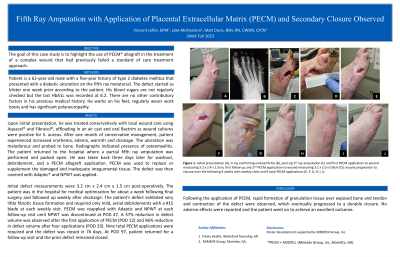Case Series/Study
(CS-091) Fifth Ray Amputation with Application of Placental Extracellular Matrix (PECM) and Secondary Closure Observed

The goal of this case series is to highlight the use of PECM allograft in the treatment of a complex wound that had previously failed a standard of care treatment approach.
Methods:
Patient is a 62-year-old male with a five-year history of type 2 diabetes mellitus that presented with a diabetic ulceration on the fifth ray metatarsal. The defect started as blister one week prior according to the patient. His blood sugars are not regularly checked but the last HbA1c was recorded at 6.2. There are no other contributory factors in his previous medical history. He works on his feet, regularly wears work boots and has significant polyneuropathy.
Results:
Upon initial presentation, he was treated conservatively with local wound care using Aquacel® and Fibracol®, offloading in an air cast and oral Bactrim as wound cultures were positive for S. aureus. After one month of conservative management, patient experienced increased erythema, edema, warmth and drainage. The ulceration was malodorous and probed to bone. Radiographs indicated presence of osteomyelitis. The patient returned to the hospital where a partial fifth ray amputation was performed and packed open. He was taken back three days later for washout, debridement, and a PECM allograft application. PECM was used to replace or supplement the damaged and inadequate integumental tissue. The defect was then covered with Adaptic® and NPWT was applied.
Initial defect measurements were 3.2 cm x 2.4 cm x 1.5 cm post-operatively. The patient was in the hospital for medical optimization for about a week following final surgery and followed up weekly after discharge. The patient’s defect exhibited very little fibrotic tissue formation and required only mild, serial debridements with a #15 blade at each weekly visit. PECM was reapplied with Adaptic and NPWT at each follow-up visit until NPWT was discontinued at POD 47. A 57% reduction in defect volume was observed after the first application of PECM (POD 12) and 96% reduction in defect volume after four applications (POD 33). Nine total PECM applications were required and the defect was closed in 76 days. At POD 97, patient returned for a follow-up visit and the prior defect remained closed.
Discussion:
Following the application of PECM, rapid formation of granulation tissue over exposed bone and tendon and contraction of the defect were observed, which eventually progressed to a durable closure. No adverse effects were reported and the patient went on to achieve an excellent outcome.
Trademarked Items:
References:

.png)